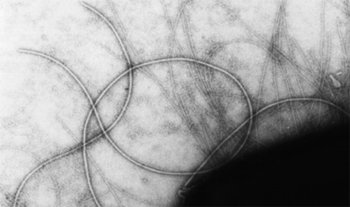Pilus
|
|
A pilus (Latin; plural : pili) is a hairlike structure on the surface of a cell, especially Gram-negative bacteria. It is an extension of the cytoplasm and used for attachment to surfaces (and is then called fimbrium) and conjugation with another cell of the same species.
Pili, sometimes called sex pili, are used for bacterial conjugation. They connect the bacterium to another of its species and build a bridge between the cytoplasm of either cell. That enables the transfer of plasmids between the bacteria. An exchanged plasmid can add new functions to a bacterium, e.g., an antibiotic resistance.
A fimbrium (Latin; plural: fimbria) (main article: fimbria) is a short pilus that is used to attach the cell to a surface. Fimbria are either located at the poles of a cell, or are evenly spread over its entire surface. Mutant bacteria that lack fimbria cannot adhere to their usual target surfaces and, thus, cannot cause diseases.
Pili generate motile force via interactions with the bacteria cytoskeleton MreB which is homologous to eukaryotic actin. The process is akin to the myosin power stroke. The external termini of the pili adhere to sold substrate, and subsequent pili contraction pulls the bacteria forward, not unlike a grappling hook.

